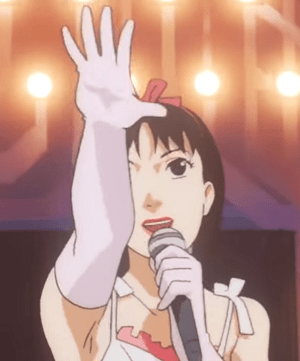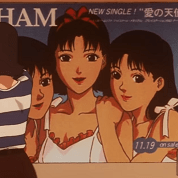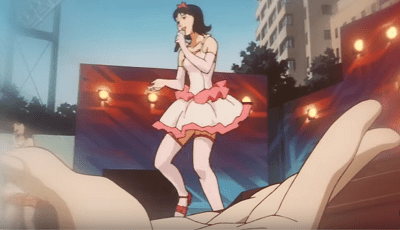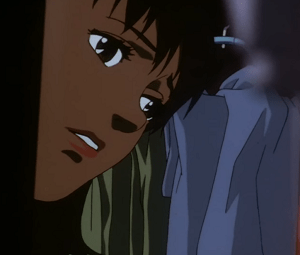
Hey everyone, it’s Kernook here, and it’s time for an anime review. Today I’ll be talking about Perfect Blue. Before I do that, though, I’d like to discuss the director behind the work very briefly.
Thank you to our patrons for supporting our content.

Satoshi Kon was a master in directorial design. He took to his craft with a keen eye for detail. Unfortunately, he passed away in 2010, leaving behind his works of art as a legacy to the anime industry.
In brief summary, Kon’s works are noteworthy to say the least and each of them are particularly unique. Frankly, his productions are incredible, even if they aren’t exactly mainstream media.
The fact of the matter is, most of Satoshi Kon’s greatest works are way ahead of their time thematically. They challenge viewers, and often require more than a single viewing.
Satoshi Kon combines the art of anime with his ability to craft an interesting narrative. His works are often saturated with several layers of metaphor to drive his stories forward. In order to completely catch every minor detail he skillfully embeds into his works, it’s best to watch them at least twice.
Fandom: Satoshi Kon
His aspiration in life was to become an animator, but thankfully he blossomed well beyond that. In his career he was credited for being…
In 1997, Satoshi Kon had built quite a name for himself. His reputation grew quickly. His ability to craft compelling stories gave him an edge in the anime industry. In the 90’s animation was striving to do new things, and he was just the sort of person able to utilize his skills to the fullest potential. In collaboration with the studio Madhouse, Satoshi Kon was able to direct his first feature length film; Perfect Blue.
Satoshi Kon’s First Film: Perfect Blue
Originally, Perfect Blue was a fictional novel under the name “Perfect Blue: Complete Metamorphosis” written by Yoshikazu Takeuchi.


The animated adaptation does make a few narrative changes, so keep that in mind. There is also a second novel named “Perfect Blue: Awaken from a Dream”. Both are worth a read if you love the Perfect Blue series.
As of writing this review, you can find both books on Amazon, same with the film.

Perfect Blue is a psychological drama. Its themes are heavy and introspective. It dives feet first into the darker aspects of what it means to be a Japanese idol, and the implications of that choice.
Thanks to its deep narrative and chilling atmosphere, it will be an unsettling animated movie for some viewers. This is by no means a children’s anime.
Perfect Blue was originally released in 1997, but in 2019 it was remastered. Now there is a blue-ray edition of the film as well. There is a dub and a sub of the series, and both will serve you well. Though I must admit, I do prefer the sub slightly over the dub.
Spoiler warning: From this point onward, there will be spoilers for the animated adaptation of Perfect Blue. You have been warned. This is a film you may want to watch before you see the spoilers.

Perfect Blue tells the personal story of a Japanese idol named Mima. She’s established and fairly successful, but she believes that she can do better. Therefore she decides to leave her singing career behind, choosing to become an actress instead.
Quite quickly, she manages to get a small role in a murder mystery series. Unfortunately, that’s when things start to go horribly wrong for Mima, and it’s the crux of the entire movie.
Now, there is something to be said about idol culture, and the mentalities surrounding it. Japanese idols are a strange concept to anyone unfamiliar with it. In truth, westerners don’t have a one-to-one comparison for idol culture, so can be hard to describe.
Basically, a Japanese idol is a teenage girl or a very young woman who fits into a societal mold. These girls are dressed up in cute outfits in order to sing, dance, and perform for their fans. Furthermore, idols are expected to behave in a certain way. They have plenty of rules to follow, and they don’t have a lot of personal freedom. Idols are meant to encourage and inspire their fans, maintaining a perfect image for the general public.
Perhaps the nearest comparison I could make is the old days of the Micky Mouse Clubs, but even that falls on its face because idols are usually not children. Rather, they are late teens or young adults.

A somewhat sinister fact to this is that normally these girls don’t come from prominent families. Most of the time, they’re nameless and unpopular at first, rising to stardom because that’s what idol fans like to see.
This cultivated narrative suggests to fans that anyone who tries hard enough has the chance to be an idol themselves. Perfect Blue portrays the dark side of idol this particular type of idol culture.
Mima can’t just leave her identity as an idol behind. As much as she might want to, Mima can’t escape who she was, or the image she portrayed. In a way you could say she is a slave to her fans.
One fan in particular starts retaliating when she decides to start acting. This new role takes away from her purity and innocence that an idol should portray. Due to that, things become dangerous very quickly for her. Sadly, this also trickles down to those she’s associated with.



As people in Mima’s social circle end up being murdered, Mima must learn to cope with these new dangers. To make matters worse, Mima has trouble coming to terms with her professional career.
She believes she making the right choices logically. Emotionally though, those choices aren’t fulfilling in the slightest. They just don’t excite her like she thought they would. Instead, she ends up just going through the motions of daily life, feeling almost numb to her success.
She doesn’t voice this outwardly as she much as she should, keeping it to herself. Inwardly, she feels as though she needs to live up to a certain expectation, and since she was once an idol, this is no surprise.

As Mima’s career path shifts, so does she as a person. She constantly finds herself placed in very uncomfortable circumstances . As dark realities start drifting to the surface, she struggles to find her footing as an actress.
Mima is forced to act out scenes for her television series that she isn’t comfortable with, and she attends photo shoots for magazines that contain nudity. This goes against Mima’s formerly squeaky clean idol identity. Sadly, she conforms in spite of her discomfort with it all.

As if all of this wasn’t enough, there’s one more detail to this sordid puzzle. A detail that truly makes this animated film something truly haunting.
Mima isn’t necessarily in her right mind. Instead, she begins to hallucinate. Her former idol identity manifests in front of her. This image begins teasing her, taunting her, and asking her to dive deeper into her own depression. This image begins to ask Mima if she’s living the life she really wanted for herself.
It happens more than once. Each time this happens, it’s rather disturbing, both to Mima and to us, the viewers.

The vision of her idol identity keeps appearing and toying with her at every opportunity. It’s as if Mima is slowly going mad. At one point Mima even sees her idol identity sitting in the back seat of someone’s car. A point that I’ll come back to later.
The mental spiral continues to get worse for Mima. She begins passing out during the day and waking inside her apartment. She has absolutely no recollection of how she got there. She begins to see photos uploaded to a fan site that she doesn’t recognize and she begins to question herself, feeling as though she’s losing her mind.
The most disturbing part of all of this is that the television series that Mima has been working mirrors this. It has all of the same basic story beats. This gives viewers several narratives layered with complex implication and metaphor.

As we watch Mima struggle, we’re inclined to wonder about who she is as a person. We’re brought to wonder just how much of her life is a fabrication, and how much of it is real. Viewers are encouraged to question the stability of Mima’s mind, and what she sees as reality.
Frankly, all of these contextual pieces would be terrifying on their own. However, mixed together the way that they are, it is truly unsettling in all the right ways. The themes linger long after the anime has been turned off, and that’s by design.
Like Anime and Gaming content? Check out our other platforms:
Perfect Blue’s Perfect Metaphors
Satoshi Kon knew how to get his point across. He understood the fine lines of media, and how to make them work in his favor. He approached Perfect Blue with a firm understanding of what he wanted to do, and how to get it done.
The meticulous editing and scene changes found in this film are some of the best I’ve seen in anime. The film relies heavily on implication and juxtaposition to carry important scenes forward.

One moment, she’ll be standing over a dead body in a scene she’s acting out.

In the next, she’ll be standing in front of an audience, preparing to perform.
These scenes compare and contrast two stressful situations for Mima. She’s wearing the same expression in both moments, but one is much more horrific than the other.
As I said above, viewers are encouraged to question her sanity and what she believes to be real. This is one key scene, among many others, that truly contextualize Mima as a character.



It’s at this point I’d like to remind you of two other important scenes. One is the scene about the photos on the fan site she found. As I said above, she has no recollection of the pictures that were taken of her. However, the clothes are certainly in her closet, even if she can’t remember buying them.
The second scene is of the moment she see’s her idol identity sitting in the passenger seat of someone else’s car. She can’t deny what she saw, but even she can admit the entire idea is pure insanity on its face.
As Mima questions herself, viewers are asked to question her as well. As the concept of reality shifts around her, we begin to see that not everything is as it seems. We realize that her experiences are not trustworthy.
We can’t help but question which of the experience she’s having is the real one. Maybe only one situation is, maybe they both are, or perhaps it’s all just a fabrication of a very ill mind. This brings me to my next point…
Who exactly is Mima?
Mima’s Conflicted Identity

Throughout the film, it becomes clear that Mima isn’t being entirely honest with herself, or those around her. As I stated above, she truly struggles to find her place in life.
She’s not a happy person, at least not professionally, socially, or emotionally. She lives a very complicated life, with several facets of her personality being hidden away from the public eye.
Mima lives a double life. It may be two sides of the same coin, but that is a very isolating thing to do. We see this play out in the film.

It’s arguable that her supreme sense of isolation leads to her unhealthy mindset and warped perception of reality. It’s also arguable that she’s isolated purely because her perceptions are warped to begin with.
Viewers will never truly know the answer, it’s left strictly up to interpretation.
Mima is rather lonely in the privacy of her own apartment. Meanwhile, her idol persona is outgoing and charismatic. Lastly, her actress persona is someplace in the middle of the other two.
These conflicting identities lead her to a crisis of sorts. At times, it seems as though the idol personality within her is trying to break lose. It seems to gain a personality of its own. The way it seems to harass her is another question in and of itself.

Are these her own personal thoughts of self hatred given form? Or is the idol within her becoming it’s own split off personality, separate from Mima as a person? Or is she simply a ghost of who Mima once was?
Once again, the answer is not so clear. While it’s true this isn’t likely a purgatory of sorts, the trials placed in front of Mima are no less troubling.
Most of what viewers see is through the eyes of Mima, and what she goes through in daily life. With these many personas in constant conflict, her personal identity gets lost in the shuffle.
It’s anyone’s guess. That’s what makes this film so good. You could debate this endlessly and never come to a final answer.
Has Perfect Blue Aged Well?
Perfect Blue was originally released in 1997. In some ways it is a product of its time. When it comes to the world itself, it shows its age in spades. Decor looks dated to be sure, and that says nothing about the world during that era of time.


Electronics in the film reflect the era of the late 90’s. As a result, so do some of the conversations in the series. For example, there’s a scene where Mima learns how to use the internet for the first time.
Televisions and computers are the sort that you would find in the late 90’s. What was once top of the line equipment now looks like a relic. If anything, I do appreciate the little Mackintosh logo at the bottom of the computer and on the box. There are plenty of little nods like this all over in the anime.

If you are old enough to remember the 90’s these are neat little additions. I’m sure that in the 90’s additions like this helped the narrative to be more immersive.
As far as the actual animation goes, it holds up quite well, even in it’s original state. Thanks to the blue-ray remastering of the anime, those who want high definition certainly have an option too. The soundtrack to the show is as haunting as it is beautiful. Each track melds into scenes flawlessly, building tension and atmosphere when it needs to.
Final Thoughts
Perfect Blue is not an anime film for everyone. In fact, I personally believe a good number of people won’t like it at all. It can be hard to recommend to the average anime viewer.
It isn’t a relaxing show, and it has some pretty brutal pacing. That, coupled with its dark and sinister themes, lead to a very complex and morally grey narrative. It is a thriller, and that can’t be understated.

The film relies heavily on its psychological drama to carry the story forward. Many scenes are purposefully unsettling, and Mima is an enigma by nature. Several questions are left unanswered and up to interpretation.
The ones that will be answered, may not be satisfactory or to your liking. That’s just the nature of this film, and Satoshi Kon’s directorial style in general.
That being said, Perfect Blue is by far one of the most compelling anime I’ve ever watched. There is so much to unpack about the world, Mima, and the concept of idol culture in Japan. If you can tolerate the concepts in the anime, you may find a real gem here.
This has been Kernook of The Demented Ferrets, where stupidity is at its finest and level grinds are par for the course. I’ll see you next time.
Meanwhile, check out some of our other great content below. You can also find more information about supporting us at the bottom of this post.
With your contributions, you make our efforts possible. Thank you for supporting our content. Patreon supporters receive access into our official Discord server, and a few other perks depending on the tier. If you don’t care for Patreon, and don’t care about perks, you can always support us through PayPal too… links below.
Those who join via Patreon get special perks, such as extra content, quicker updates, and more.
Patreon Supporters:
($3) Little Ferrets: None
($5) Demented Minions: Francis Murphy and Andrew Wheal.
($7) Fandom Ferret: None
($14) True Blue Ferret: None.
($25) Premium Ferret: None.
($50) Round Table Ferret/Fluffy Ferret: Josh Sayer





I’m glad to see some appreciation for Perfect Blue on there. It’s a great film debut or not. It was so creative and well-written. Yes, I know there’s dated elements, but the positives far outweigh the negatives. There would be no Black Swan without this movie. Also, did you know Darren Aronovsky bought the rights to this movie just so he can recreate the “girl screaming in a bathtub” scene in Requiem for a Dream?
LikeLike
I knew that was the rumor, however Darren has denied Perfect Blue being an influence when making Black Swan. I try my best not to do this, particularly where Darren Aronovsky is concerned regarding Black Swan. There just isn’t any proof that he did purchase the rights to my knowledge. Worst still, the original interview of his denial of the purchase is now very difficult to find.
Perfect Blue and Black Swan are vastly different when you cut down to the core of the movies and their foundational ideas. They simply share emotional tone, a few general scene compositions and similar main characters. There are plenty of similarities, sure, but they are fundamentally different movies by their nature why is why I don’t think much of the claim one way or the other.
I’m happy to just allow it to be a rumor.
LikeLiked by 1 person
I knew about him denying the influence with Black Swan and I do agree he should’ve owned up to it with the obvious similarities. The rights was for Requiem for a Dream and not Black Swan. That’s a bummer how those interviews have been tough to find. Granted, Satoshi Kon did get ripped off so much by Christopher Nolan when he made the knock-off Paprika…I mean Inception.
LikeLike
Oh crap, sorry, I had my thumb up my behind I that one. I hadn’t heard about Requiem for a Dream when in regards to rights being purchased. I’d like to see the paper trail of that if you happen to know where to find it, because that’s interesting as hell.
I think ultimately Satoshi Kon’s influences outside of the anime world aren’t largely spoken about simply because mainstream media don’t treat anime as the art form it truly is. The stigma prevents anime and their creators the due justice and accreditation they deserve. Many other gifted creators were treated like garbage too over the years. I recall the first time I ever saw a hit film credit an anime for inspiration. That was the Matrix in regards to Ghost in the Shell.
It’s a sad fact, but that’s one of the reasons I’m going to take my time talking about creators and their influences when and where I can. Kon simply came to mind as one of the first I should speak of because his works gave me so many great memories.
LikeLiked by 1 person
Don’t worry about it. I’m glad I was able to clarify something. Here’s a link involving a scene comparison with both movies. https://twitter.com/FilmFreeway/status/1243755108615282688.
If I ever find the interview about the Black Swan situation, then I’ll let you know.
That makes sense and it’s just sad. I was certainly made fun of for liking anime when I was in high school and college. I do want others to be credited. Good point about The Matrix and Ghost in the Shell. Don’t even get me started about The Lion King shamelessly plagiarizing Kimba the White Lion or using a stolen South African song as part of the soundtrack.
Right, but I’m glad you’ve been giving creators the credit they righteously deserve. Kon certainly deserves way more recognition. I even made it a goal on one of my blogs to review his whole filmography which I completed last year.
LikeLike
[…] [Anime]Loot River – [Game]Monster – [Anime]My Hero Academia (Season 1) – [Anime]Perfect Blue – [Anime]Resident Evil 1 (1996) – [Game]Resident Evil 1.5 Prototype– [ Game]Resident Evil 2 […]
LikeLike
[…] [Anime]Loot River – [Game]Monster – [Anime]My Hero Academia (Season 1) – [Anime]Perfect Blue – [Anime]Resident Evil 1 (1996) – [Game]Resident Evil 1.5 Prototype– [ Game]Resident Evil 2 […]
LikeLike